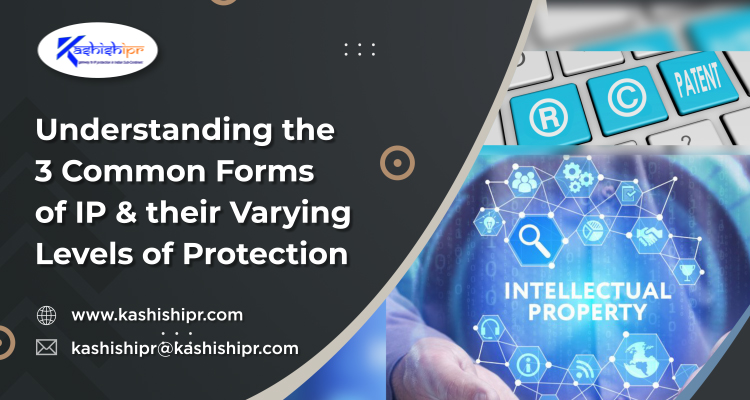
The term ‘Intellectual Property (IP)‘ is like the term ‘Organic’ to some extent, i.e., people across the globe possess some knowledge as to what it means but aren’t crystal clear on its specific details.
People are aware of the term ‘Property,’ which relates to the regulations, rules, and laws of ‘Real Property’ or ‘Real Estate,’ i.e., land. One way in which the real estate owners designate the boundaries of their assets, which is the land, is by putting a fence around it. If any unauthorized person or party enters such a safeguarded piece of land, it is referred to as trespassing. In the same way round, IP puts a virtual fence around the property or assets that it safeguards. If any unauthorized person tries crossing that fence, it is referred to as IP Infringement.
In this article, we will be throwing light on the 03 most common forms of IP, including trademarks, copyright, and patents, along with the different and varying levels of protection that they offer.

- Trademarks
Trademarks (referred to as logos and brand names in a layman’s language) are the source identifiers intended to safeguard the general public from getting confused about the origin of products and services available in the market. When we talk about Trademark Protection, it can last forever, provided the trademark owner renews his Registered Trademark at appropriate levels. In most nations around the world, trademark protection lasts for ten years from the date of filing, which can be renewed indefinitely for consecutive periods of ten years each. If we mention the famous and widely-recognized trademarks like BMW, Pepsi, and Apple, the aspects that shall immediately come to your mind include not only their specific products but also the characteristics, features, and particular level of quality, be it high or low, associated with such products. For instance, when a consumer buys an iPhone, the expectation is for the smartphone to operate well with a fine operating system and processor that would work for a long time.
If an unauthorized person sells an iPhone under the Apple brand name with quality and characteristics that are pretty lower than a genuine iPhone, a buyer may get confused and may eventually end up buying the counterfeit iPhone for a high price expecting it to be an iPhone when, in reality, it is of much poorer quality. Although fewer people buying an iPhone from a street vendor may get confused as to the expected quality of that smartphone, there exist reasonably high-quality super fakes as well – contributing enormously to the counterfeit smartphones sold every year worldwide with an immense net profit.
- Copyright
Copyright safeguards the original works of authorship like music and lyrics, novels, software, paintings, to name a few. Providing Copyright Protection to authors induces and fosters original ideas and creativity. Furthermore, it enables the ones who create original works to extract profits from their respective works. In most nations globally, the copyright protection term lasts for the lifetime of the author plus seventy years following his death; however, the protection period varies depending on the type of work. For instance, the duration of copyright protection for original literary, musical, dramatic, and artistic works in India is the lifetime of the author plus sixty years counted from the year following the death of the author.
In the present digital era, a significant amount of content is freely available on the internet for anyone and everyone to use. Consequently, there are numerous examples of unauthorized users and third parties reproducing such content to extract benefits, only to have to pay substantial monetary damages to the copyright authors and owners who successfully enforce their rights. In this scenario, it is highly suggested to think about the rights copyright owners or authors may have and whether you need to request them to use their creative work. If you proceed blindly in this case, you undertake an unnecessary risk of committing Copyright Infringement and may have to face the legal and monetary consequences that come with it.
- Patents
Patents safeguard the innovations or inventions that are novel, non-obvious, industrially applicable, and possess an inventive step. A granted patent describes the features of an invention or innovation and how it works in well-written and illustrated detail. Irrespective of what may be described by an invention or innovation, a patent only protects what is claimed, i.e., what is written in the patent claims or numbered sentences at the end of a Patent Application. The patent claims put a virtual fence around the invention and allow the patent owner to prevent others from using, manufacturing, distributing, or selling the protected invention without seeking his permission. In general, patents last for twenty years from the date of filing (it may vary from one country to another).
As an example of a patent claim, let us assume that someone has invented a ballpoint pen and described it in detail in the patent application. The patent claim says, “A writing instrument consisting of an elongate body with a marking material projecting from the elongate body.” Now, if an unauthorized person or entity uses, manufactures, distributes, or sells a pen with the previously mentioned claimed features, the patent owner could sue that person or entity alleging Patent Infringement. It is worth observing how the said patent claim could also include other writing instruments like a pencil, sketch pen, or even a kohl stick – all of which may have an elongate body with a marking material projecting from that body. ✅ For more visit: https://www.kashishipr.com/
No comments:
Post a Comment